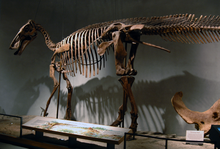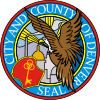Denver Museum of Nature and Science
 Denver Museum of Nature & Science | |
 | |
| Established | 1900 |
|---|---|
| Location | Denver, Colorado |
| Type | Natural History, Science |
| President | George Sparks [1] |
| Website | Museum website |
The Denver Museum of Nature & Science is a municipal natural history and science museum in Denver, Colorado. It is a resource for informal science education in the Rocky Mountain region. A variety of exhibitions, programs, and activities help museum visitors learn about the natural history of Colorado, Earth, and the universe. The 716,000-square-foot (66,519 m2) building houses more than one million objects in its collections including natural history and anthropological materials, as well as archival and library resources.
The museum is an independent, nonprofit institution with approximately 350 full-time and part-time staff, more than 1,800 volunteers, and a 25-member Board of Trustees. It is accredited by the American Alliance of Museums (AAM)[2] and is a Smithsonian Institution Affiliate.
Education programs
The museum provides programming in six main areas. The exhibitions, IMAX films[3], lectures, classes, and programs pertain to one or more of the following core competencies: anthropology, geology, health science, paleontology, space science, and zoology. More than 300,000 students and teachers visit the museum with school groups each year. In addition, the museum has science outreach programs and distance–learning opportunities for families, schools and surrounding communities.[4] The museum also offers ongoing professional training workshops for teachers.
History


In 1868, Edwin Carter moved into a tiny cabin in Breckenridge, Colorado, to pursue his passion, the scientific study of the birds and mammals of the Rocky Mountains. Almost single handedly, Carter assembled one of the most complete collections of Colorado fauna then in existence.
Word of Carter's collection spread and, in 1892, a group of prominent Denver citizens declared their interest in moving his collection to the capital city for all to see. Carter offered to sell the entire collection for $10,000. The founders also secured a collection of butterflies and moths, and a collection of crystallized gold.
Together, these three collections formed the nucleus of what would become the Colorado Museum of Natural History, officially incorporated on December 6, 1900. After years of preparation and construction, the Colorado Museum of Natural History finally opened to the public on July 1, 1908. John Campion, the first president of the board, said in his dedication address, “A museum of natural history is never finished". The first director was hired and quickly recruited staff to build more exhibits and create public programs. By 1918, another wing had opened and research efforts were well underway.
A discovery in 1926 brought attention to the museum. A crew working near Folsom, New Mexico, unearthed stone projectile points alongside the bones of an extinct bison species. These Folsom points proved that humans lived in North America more than 10,000 years ago, hundreds of years earlier than previously believed.[citation needed]
The museum is partially funded by the Scientific and Cultural Facilities District (SCFD), which was created by area voters in 1988.[5]
Permanent exhibits

Discovery Zone is a hands-on educational center geared toward children, allowing them to dig up dinosaurs, make craft, and inspect insects.[6]
Egyptian Mummies uses two mummies and their tomb artifacts to teach how the ancient civilization of Egypt preserved its dead.[7]
Expedition Health teaches visitors about the human body.[8]
Gems & Minerals is a re-created mine where visitors can examine many colorful crystals and minerals found both locally and globally.[9]
North American Indian Cultures explores the diversity among Native American groups and the practicality and artistry of their everyday objects.[10]
Prehistoric Journey traces the evolution of life on Earth. Displays include skeletons of diplodocus, allosaurus, and stegosaurus, a sea lilie reef diorama from 435 million years ago, a cast/replica skull of the ancient placoderm fish, dunkleosteus, a collection of trilobites.[11]
Space Odyssey is about the Universe and our place in it.[12]
Wildlife Exhibits are animal dioramas showing scenes of daily life of many different animals.[13]
Research and Collections
- The anthropology Collection contains over 50,000 objects and is made up of archaeological and ethnological artifacts from North America. The department also curates collections from Central and South America, Africa, Asia, and Oceania. Additional holdings include the 800-piece Ethnological Art Collection, and archival photographs and documents. The department is fully committed to compliance with the 1990 Native American Graves Protection and Repatriation Act (NAGPRA) and all other national and international laws that impact anthropological objects.
- Earth Sciences Collection consists of six main groups: vertebrate paleontology, paleobotany, invertebrate paleontology, minerals, meteorites, and micromount.
- Health Sciences Collection is composed of rare and unique human anatomy specimens, as well as a small selection of pieces of medical importance.
- Space Sciences Lab is responsible for the museum's Scientific Instruments Collection. This collection is composed of instruments that have been used by museum staff members or are excellent type-examples of particular instruments. In addition, the Department of Space Sciences maintains a large digital collection of images and multimedia assets (presentations, video, visualizations) of use in research, public programs, and Space Odyssey.
- Zoology Collection houses over 900,000 specimens or specimen lots (groups of specimens) including over 40,000 vials of arachnids (spiders and their relatives), over 780,000 insects, especially the orders Coleoptera (the beetles) and Lepidoptera (the butterflies and moths), 17,000 shell lots representing shells from all over the world, approximately 52,000 bird specimens, including a significant nest and egg collection, over 14,000 specimens of mammals, including several threatened or endangered species and several species now considered extinct. The small botany collection includes over 2,500 specimens representing 130 families. Specimens records are published, via Arctos and Symbiota, to data portals such as SCAN, ORNIS, MANIS, VertNet, GenBank, and BISON.[14][15][16][17][18][19][20]
- Bailey Library and Archives focuses on anthropology, earth sciences, health sciences, space sciences, zoology, the Rocky Mountain West, and museum studies. It contains over 53,000 publications, 2,500 rare books, and 9,000 volumes of scientific periodicals.[21]
Gates Planetarium
Gates Planetarium is a 125-seat planetarium that features unidirectional, semi-reclining stadium seating, 16.4 surround-sound system featuring Ambisonic, a 3-D spatial sound system, and a perforated metal dome, 56 ft (17 m) in diameter and tilted 25 degrees. The current planetarium replaces an older, dome-style planetarium.[22]
Phipps IMAX Theater
The Phipps IMAX Theater on the second floor of the museum was built as the Phipps Auditorium in 1940, and was used for lectures, concerts, and films until 1980. Renovated and reopened in 1983 as the Phipps IMAX Theater, it seats 440 people and now shows large-format IMAX films daily.
Morgridge Family Exploration Center and Avenir Collections Facility
The Morgridge Family Exploration Center constitutes three above-ground levels that encourage visitors to learn about science and the natural world. The center includes Exploration Studios, a new temporary exhibition gallery, an atrium space, a completely-redeveloped Discovery Zone for early learners, and the outdoor, Boettcher Plaza with unique public art.
The Avenir Collections Center includes 63,000 square feet in two underground levels devoted to housing for nearly 1.5 million artifacts and specimens, ensuring they are preserved for the public for generations to come.
Museum secrets
The museum contains a number of hidden secrets that visitors may search for. Kent Pendleton, one of the museum's diorama painters, painted eight elves in his work, hidden throughout the museum. Guests are encouraged to search for the elves with a printable scavenger hunt.[23][24][25] In the IMAX lobby entrance there are several painted pictures hidden on the walls relating to Star Wars.[24][25]
See also
References
- ^ "George Sparks". dmns.org. Denver Museum of Nature and Science. Retrieved 11 August 2010.
- ^ "List of Accredited Museums" (PDF). aam-us.org. American Alliance of Museums. Retrieved 6 April 2013.
- ^ IMAX
- ^ "George Sparks". dmns.org. Denver Museum of Nature and Science. Retrieved 11 August 2010.
- ^ "SCFD and the Museum". dmns.org. Denver Museum of Nature and Science. Retrieved 11 August 2010.
- ^ "Discovery Zone". dmns.org. Denver Museum of Nature and Science. Retrieved 11 August 2010.
- ^ "Egyptian Mummies". dmns.org. Denver Museum of Nature and Science. Retrieved 11 August 2010.
- ^ "Expedition Health". dmns.org. Denver Museum of Nature and Science. Retrieved 11 August 2010.
- ^ "Gems & Minerals". dmns.org. Denver Museum of Nature and Science. Retrieved 11 August 2010.
- ^ "North American Indian Cultures". dmns.org. Denver Museum of Nature and Science. Retrieved 11 August 2010.
- ^ "Prehistoric Journey". dmns.org. Denver Museum of Nature and Science. Retrieved 11 August 2010.
- ^ "Space Odyssey". dmns.org. Denver Museum of Nature and Science. Retrieved 11 August 2010.
- ^ "Wildlife Exhibits". dmns.org. Denver Museum of Nature and Science. Retrieved 11 August 2010.
- ^ Arctos
- ^ ORNIS
- ^ MANiS
- ^ GBIF
- ^ GenBank
- ^ VertNet
- ^ BISON
- ^ Bailey Library and Archives
- ^ Gates Planetarium
- ^ printable scavenger hunt
- ^ a b Elves at Denver Museum of Nature and Science
- ^ a b , Surprises at Denver Museum of Nature and Science PDF description and location of Museum Secrets
External links
- Use dmy dates from June 2011
- Museums in Denver, Colorado
- Institutions accredited by the American Alliance of Museums
- IMAX venues
- Dinosaur museums in the United States
- Natural history museums in Colorado
- Science museums in Colorado
- Egyptological collections in the United States
- Paleontology in Colorado
- Mesoamerican art museums in the United States
- Native American museums in Colorado


